It’s no secret that the Pacific Northwest is the coffee capital of the world. There’s a coffee shop on every corner (sometimes two!), and a never-ending thirst for the latest and greatest new drink. The passion for coffee spills over into passion for soapmaking, so when we brought in the brand new Espresso Fragrance Oil, we went to work designing the most coffee-tastic soap we could.
The Espresso Fragrance Oil is a true espresso scent. Whereas Turkish Mocha has hints of sweetness and cream and Chocolate Espresso Cybilla is brimming with chocolate-y goodness, Espresso is for the coffee purist. Along with a recipe that includes Coffee Butter, Cocoa Butter, Hazelnut Oil and real coffee grounds, this is the ultimate soap for coffee lovers everywhere.
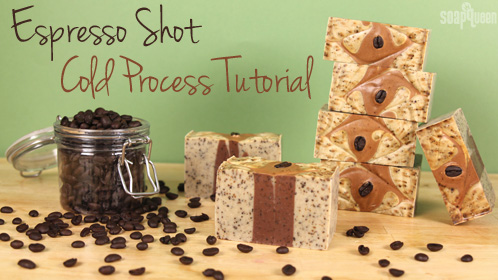
What You’ll Need:
5.5 oz. Cocoa Butter
13.7 oz. Coconut Oil
2.7 oz. Coffee Butter
2.7 oz. Hazelnut Oil
16.5 oz. Olive Oil
13.7 oz. Palm Oil
7.7 oz. Sodium Hydroxide
18.1 oz. distilled water
3.5 oz. Espresso Fragrance Oil
5 lb. Wood Log Mold with Slide Bottom and Silicone Liner
3 tbsp. coffee grounds
 Click here to add everything you need for this project (except the coffee grounds) to your Bramble Berry shopping cart!
Click here to add everything you need for this project (except the coffee grounds) to your Bramble Berry shopping cart!
If you’ve never made Cold Process soap before, stop here! I highly recommend checking out our FREE four part SoapQueen.tv series on Cold Process Soapmaking, especially the episode on lye safety. And if you’d rather do some reading, Bramble Berry carries a wide range of books on the topic, including my newest book, Soap Crafting. You can also checkout the digital downloads for that instant gratification factor.
SAFETY FIRST: Suit up for safe handling practices! That means goggles, gloves and long sleeves. Make sure kids, pets, and other distractions and tripping hazards are out of the house or don’t have access to your soaping space. Always soap in a well-ventilated area.

COLOR PREP: To ensure that the Titanium Dioxide blends smoothly into the soap batter, we recommend micronizing it before dispersing it in oil. To micronize colorant, simply use a coffee grinder to blend the colorant to break up any clumps of color and prevent streaks of white from showing in the final soap. We like to use a coffee grinder that has a removable, stainless steel mixing area for easy cleaning. Then, disperse 1 teaspoon of the colorant into 1 tablespoon of Sunflower or Sweet Almond Oil (or any other liquid oil). Then, disperse 1 teaspoon Brown oxide into 1 tablespoon of light liquid oil. Use a mini mixer to get the clumps of color worked out smoothly.
COFFEE GROUNDS: You can use either dry or used coffee grounds for this project. If you do use dry grounds like we did, be aware that they may “bleed” and form a small halo of color around them. If you don’t want the halo effect, make yourself a pot of joe and use the leftover grounds!
ONE: Slowly and carefully add the lye to the water and gently stir until the lye has fully dissolved and the liquid is clear. Set aside to cool.
TWO: Combine the Cocoa Butter, Coconut Oil, Coffee Butter, Hazelnut Oil, Olive Oil and Palm oils (remember to fully melt then mix your entire container of Palm Oil before portioning). Once the lye water and the oils have cooled to 130 degrees or below (and are ideally within 10 degrees of each other), add the lye water to the oils and stick blend until thin trace. If you’d like a harder bar of soap that releases faster from the mold, you can add Sodium Lactate to the cooled lye water. Use 1 teaspoon of Sodium Lactate per pound of oils in the recipe. For this recipe, you’d add about 3 tsp. Sodium Lactate.
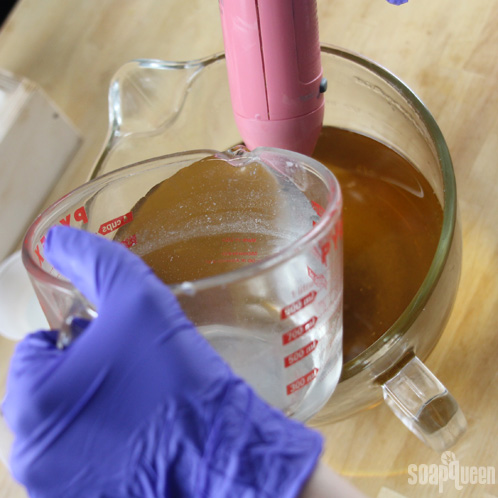
 THREE: Once the batter has reached a light trace, pour 3 cups of the soap batter into a separate container.
THREE: Once the batter has reached a light trace, pour 3 cups of the soap batter into a separate container.

FOUR: Add 1 tbs. of coffee grounds into the small container, and 2 tbs. of coffee grounds into the larger container. Use a whisk to gently combine.

FIVE: Add 3 tps. of the dispersed Titanium Dioxide into the large container. Use a whisk to mix in.

SIX: Add 3 tps. dispersed Brown Oxide to the small container, and use a whisk to thoroughly combine.

SEVEN: Add half of the Espresso Fragrance Oil to the small container, and half to the large container. You can eyeball it, but if you want to be exact then add 1.7 oz. of fragrance to each container. Use a whisk to mix in.

EIGHT: Gently pour the brown soap into the center of the Multi-Pour Sectioning Tool. To help the soap batter evenly spread throughout the middle section, you can alternate pouring from each end.

NINE: Once the center section is full, pour the white batter into the outside sections.

TEN: Pour slowly, and alternate pouring into different ends to evenly disperse the batter in the Multi-Pour Sectioning Tool.

ELEVEN: Once all sections are full, slowly remove the center piece straight up out of the soap. Set aside.
 TWELVE: Slowly pull the long center dividers straight up, and set aside.
TWELVE: Slowly pull the long center dividers straight up, and set aside.
 THIRTEEN: Pull the small end liners straight out, and set aside.
THIRTEEN: Pull the small end liners straight out, and set aside.
 FOURTEEN: Once all the pieces have been removed, tap the soap mold firmly on the table to smooth out the sections and release any air bubbles. Beginning in the corner of the mold, insert a wooden chopstick or dowel to the bottom of the mold and make a zig-zag pattern at a 45 degree angle down the length of the mold.
FOURTEEN: Once all the pieces have been removed, tap the soap mold firmly on the table to smooth out the sections and release any air bubbles. Beginning in the corner of the mold, insert a wooden chopstick or dowel to the bottom of the mold and make a zig-zag pattern at a 45 degree angle down the length of the mold.

 FIFTEEN: Once you have created the zig-zag down the length of the mold once, it’s time to go back and do it again! Starting on the opposite corner on the same end of the mold you began with the first time, use your chopstick or dowel to cross through the existing lines, creating an argyle-like pattern.
FIFTEEN: Once you have created the zig-zag down the length of the mold once, it’s time to go back and do it again! Starting on the opposite corner on the same end of the mold you began with the first time, use your chopstick or dowel to cross through the existing lines, creating an argyle-like pattern.
 SIXTEEN: Gently place whole coffee beans in the center of each swirl. Spray with 99% isopropyl alcohol to prevent soda ash.
SIXTEEN: Gently place whole coffee beans in the center of each swirl. Spray with 99% isopropyl alcohol to prevent soda ash.

 SEVENTEEN: Allow the soap to sit in the mold for 3-4 days before unmolding. Cut soap between the coffee beans, so they are in the center of each bar. Allow the soap to cure for 4-6 weeks and enjoy!
SEVENTEEN: Allow the soap to sit in the mold for 3-4 days before unmolding. Cut soap between the coffee beans, so they are in the center of each bar. Allow the soap to cure for 4-6 weeks and enjoy!
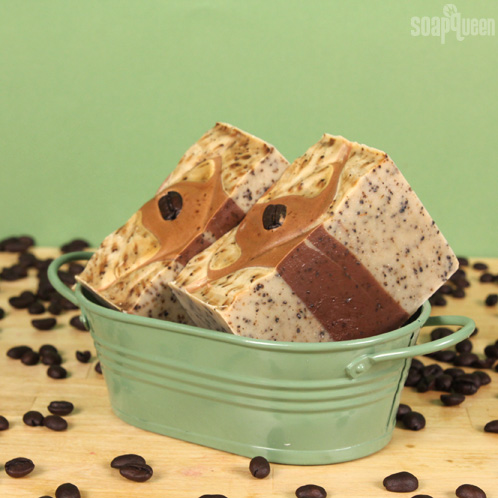
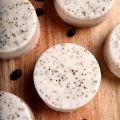
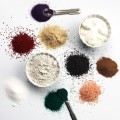
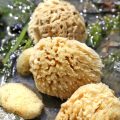
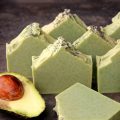
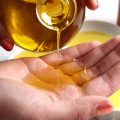
GREAT tutorial, very easy to follow for a novice soaper. I made this yesterday, and while it did not come out as perfect-looking on top as yours, it still looks pretty darn good. The Espresso FO smells sooo good. Can’t wait to cut into it!
I made this recipe earlier this week with sweet almond instead of hazelnut, and first the whole thing riced and separated. I stick blended it into shape, but when I cut it after unmolding it was a little sticky, and almost looks like chunks in it. Not ‘zapping’ and lathers fine (I wore gloves) do you think it’s safe to use?
Hi Andrea!
I’m sorry that soap separated on you! That can happen with certain fragrances, but Espresso Fragrance Oil performs well. I’m wondering if it may be a temperature thing. How hot were your oils and lye?
If the soap isn’t zapping that’s a good sign! I would recommend pH testing it to be extra careful: http://www.soapqueen.com/bath-and-body-tutorials/tips-and-tricks/test-ph-red-cabbage/
If that soap is around 9-10 pH, it’s perfectly fine to use. If it’s higher than that, don’t throw it out! Lye heavy recipes make great laundry soap.
Three DIY Laundry Soap Recipes: http://www.soapqueen.com/bath-and-body-tutorials/home-crafts/three-diy-laundry-soap-recipes/
-Kelsey with Bramble Berry
Except not so sure about coffee grounds in the laundry! I made this recipe exactly as instructed with lye @120° and oils @122.5°. All was well till the FO went in. Then it started to have a very fine grainy texture. I have only been soaping about 1 year but don’t think I’ve ever seen ricing. Is that what that texture was? I stirred it vigorously with whisk but had to pour it cuz by that time it was starting to really thicken up. Don’t know what the final soap will look like, texture-wise, but I enjoyed making this recipe.
Hi Martha!
Ricing creates lumps in the soap batter that sort of remind me of tapioca pudding! You can see an example of ricing here: http://www.soapqueen.com/bath-and-body-tutorials/tips-and-tricks/soap-behaving-badly/
Did you use the Espresso Fragrance Oil? Did the soap start to thicken and get grainy as soon as the fragrance oil went in? Let me know and I can help you troubleshoot.
-Kelsey with Bramble Berry
Yes to both questions.
What temperature was your fragrance oil? The reason I ask is because if it’s cold, it can start to harden the oils and butters in this recipe when it’s added. Thanks for answering my questions!
-Kelsey with Bramble Berry
Hi
When I run the recipe through soapcalc to get metric weight it says INS is higher then Iodine ?
I thought to get a harder bar it’s usual that the Iodine is higher then the INS ?
Thank you
Hi Phanie!
We don’t use INS numbers for our recipes. We find they don’t accurately predict if a soap will feel good on the skin. Read more about INS numbers here: http://www.soapqueen.com/bath-and-body-tutorials/cold-process-soap/ins-numbers-for-soapmaking/
We think the best way to see how a soap will feel is to give it a try! Everyone’s preference is a bit different when it comes to soap. Some people prefer really soft bars, while others love firm bars. In order to find your perfect bar, we recommend testing several recipes and seeing which one you like best.
This recipe will be on the firmer side! It has hard oils like coconut, palm and cocoa butter. It’s also very moisturizing because of the coffee butter, hazelnut oil and olive oil. It won’t have as much lather as a bar with castor oil. If you like lots of bubbles, you can add castor oil at 2-5% in the recipe.
Read more about common oils and what properties they add to soap here: http://www.soapqueen.com/bath-and-body-tutorials/tips-and-tricks/free-beginners-guide-to-soapmaking-common-soapmaking-oils/
This post on Formulating Cold Process Recipes is helpful as well: http://www.soapqueen.com/bath-and-body-tutorials/tips-and-tricks/formulating-cold-process-recipes/
-Kelsey with Bramble Berry
Hello and thank you for all these helpful beautiful videos and recipes. I have just tried more advanced soap and didnt go well. The soap got too difficult to work with, separate in to different containers and colour:o( I was reading your posts and I think I didnt know that light trace is also ok = more liquidy soap, easier to work with… could it be?
Thank you very much for your help.
Adela
Hi Adela!
Just to clarify, did the soap get a bit too thick to work with? If so, can you tell me a bit more about your recipe, including the oils and fragrance you used? Also, what temperatures did you soap at, and how long did you stick blend for? Let me know and I’ll help you troubleshoot!
-Kelsey with Bramble Berry
been making cp soap for 2 months would now like to add color. can not figure out what to use. help!!!!
Hi Joyce!
You have come to the right place, we can definitely help you out!
My favorite color to use in cold process soap is pigments. They are stable in cold process soap and create gorgeous shades.
Pigments: https://www.brambleberry.com/Pigments-C461.aspx
To use them, we recommend mixing at a rate of 1 teaspoon of the powdered pigment in 1 tablespoon of a lightweight liquid oil, like sweet almond oil. If you have a larger batch, that may need to be increased to 2 teaspoons into 2 tablespoons, or 3 into 3. Then, add 1 dispersed teaspoon at a time until you get a color you like.
Sweet almond oil: https://www.brambleberry.com/Sweet-Almond-Oil-P3205.aspx
We have some great posts and resources that talk more about how to use color in soap! They’re very helpful. I’ll include links below.
How to Prepare Colorants for Cold Process Soap: http://www.soapqueen.com/bath-and-body-tutorials/tips-and-tricks/learn-prepare-colorants-cold-process-soap-making/
How to Get Vibrant Colorants in Soap: http://www.soapqueen.com/bath-and-body-tutorials/tips-and-tricks/how-to-get-vibrant-colors-in-soap/
Talk It Out Tuesday: Colorants: http://www.soapqueen.com/bath-and-body-tutorials/tips-and-tricks/talk-it-out-tuesday-colorants/
This video uses several pigments and shows you the process of adding them: http://www.soapqueen.com/bath-and-body-tutorials/cold-process-soap/silky-berry-cold-process-soap-on-soap-queen-tv/
If you have any other questions, let me know!
-Kelsey with Bramble Berry
I have really enjoyed watching your soap making skills! I am only beginning making soap, so you have been so helpful!
So glad you’re enjoying the tutorials Miriam, and I’m excited that you’re starting to soap! If you have any questions, feel free to let us know. We are happy to help.
-Kelsey with Bramble Berry
Can you tell me how much this recipe is superfatted? Thanks so much!
Absolutely! This recipe is superfatted at 5%.
-Kelsey with Bramble Berry
This was my very first time making cp soap and I’m pretty happy with the results excepted for one little thing. My soap is a little crumbly but not too bad. I used frozen coffee instead of water and put the soap in the freezer. Could the freezer be the culprit?
Hi Marie!
How long did you wait before cutting that soap? If the soap is too firm, it can be a bit crumbly when cutting. We usually recommend letting the soap sit 3-4 days before cutting. It can also happen if too much sodium lactate is used. Did you add any sodium lactate, and if so, how much?
It may also be lye heavy. To check for lye heaviness, tap a bar on your tongue. If it “zaps” you, that means it’s lye heavy. You can also use pH strips or cabbage juice to check for lye heaviness. Find out how to do that here: http://www.soapqueen.com/bath-and-body-tutorials/tips-and-tricks/test-ph-red-cabbage/
If it isn’t lye heavy, that soap is just fine to use! If it is, you can use your soap to make laundry soap!
Three DIY Laundry Soap Recipes: http://www.soapqueen.com/bath-and-body-tutorials/home-crafts/three-diy-laundry-soap-recipes/
Let me know and we’ll get this figured out!
-Kelsey with Bramble Berry
I cut the soap the day after I made it so 24 hours (ish). I did use sodium lactate – 1 tsp. however I put it in at trace. That was my fault for not reading the instruction on sodium lactate. I did the zap test and no zap. I ran the recipe through the lye calc. This is the recipe I used:
Cocoa Butter 1.27oz 10.56%
Coconut Oil (76 Degrees) 3.16oz 26.30%
Mango Butter 0.62oz 5.18%
Olive Oil (Pomace) 3.80oz 31.67%
Palm Oil 3.16oz 26.30%
Lye 1.7oz
liquid 4.0oz
It’s been curing for about 6 days now and it doesn’t seem to be as crumbly. I does have a hint of lye smell to it. I don’t know what I did. Should I play it safe and use it as laundry soap? I wanted to use it as a basic kitchen soap. Thank you for all your help! I just wanted to make some soap.
Hi Marie!
We recommend about 1 tsp. of sodium lactate per pound of oils, so you used the exact right amount! I don’t think that sodium lactate was the culprit.
I’m wondering if the soap was just a bit soft. That can create drag marks, or the soap may want to fall apart. Did the soap feel soft to the touch, or did it want to stick to the mold? If so, you can let it sit a couple more days in the mold until it’s firm to the touch. Waiting is definitely hard to do (I know, I’m very impatient), but will give you nice smooth cuts.
I would recommend zap testing it again over the next couple days. If it’s not zapping you, your soap will be absolutely fine to use! It will feel great on your skin.
-Kelsey with Bramble Berry
When making soap can you sub milk for water in any recipes?
Hi Tommie!
You can! Milk gives a silky, creamy feeling to your soap. You can substitute with 100% milk, or do a mixture of water and milk. Learn how much lye and water to add with our Lye Calculator: http://www.soapqueen.com/bath-and-body-tutorials/cold-process-soap/using-the-bramble-berry-lye-calculator-2/
Working with milk is a little more tricky than water. If milk gets too hot, it can scald. That causes discoloration and an unpleasant smell. To prevent this, we recommend freezing the milk before adding the lye. Then, put your mold in the freezer after the soap is in the mold. Learn more in the Add Lye to Milk for Cold Process Soap post: http://www.soapqueen.com/bath-and-body-tutorials/tips-and-tricks/how-to-add-lye-to-milk-for-cold-process-soap/
-Kelsey with Bramble Berry
I need some help and I’m not really sure where to post it. I made a variation of this soap using a simple soap recipe of equal parts rice bran oil, vegetable shortening, coconut oil, and sunflower oil. I mixed the coffee with the lye and let it cool. I made this soap twice and each time the soap basically exploded out of the mold. Do you know why? The first time I thought maybe it was too hot so the second time I tried to make it, I popped it into the freezer as soon as I molded it and when I just looked, it had done the same thing
Hi there!
This is a great place to ask questions – we are happy to help.
Typically, soap volcanoes if it gets overheated. What temperature were you soaping at? Let me know and I’ll help you troubleshoot!
You can read more about soap volcanoes in the Soap Behaving Badly post: http://www.soapqueen.com/bath-and-body-tutorials/tips-and-tricks/soap-behaving-badly/
-Kelsey with Bramble Berry
I wonder what would happen if you used brewed coffee instead of water in the lye mixture?
Hi Jan!
You can absolutely use coffee instead of water! I would recommend freezing the coffee into cubes before adding the lye. If you add the lye to warm or hot coffee, it can boil over.
Also, the lye and coffee mixture does have a pretty strong smell and a dark color. The smell will fade in cold process soap, but the color will make your soap a little darker.
-Kelsey with Bramble Berry
Quick question regarding using brewed coffee in soap, as I’m planning to make a coffee soap (probably just using quick mix though): Why do you need to freeze the coffee? I thought freezing things like milk etc. was because of the sugars potentially caramelizing with the heat from the lye. Does brewed coffee have sugars in it that could overheat?
Also, in my research I’ve read about “split batch,” where you use less water with the lye, and replace the missing water with something else (beer, coffee) in the oil mixture before adding the lye water. This way, you don’t need to use the freezing method. I’ve not done this though. I’d really like to try using alternative liquids, and am trying to figure out the best and simplest way to do it!
Thanks! Love the tutorial!
Hi Adrianne!
That’s a great question! You want to freeze products like milk to prevent the natural fats and sugars from scorching. With coffee, it’s more for the smell and the color. When the lye is added to coffee, it heats it up really quickly. This discolors the coffee and creates an unpleasant smell. Freezing the coffee beforehand helps prevent some of that discoloration and smell.
You can definitely use a combination of distilled water and coffee if you like! It requires a little bit less prep beforehand, and you still get to use a fun alternative liquid. You can split it half and half, or use more water or coffee. Whichever you prefer. In that case, I would still recommend cooling the coffee in the fridge beforehand for the same reason – preventing the smell and discoloration slightly.
Find out how much liquid to use with our Lye Calculator: https://www.brambleberry.com/Pages/Lye-Calculator.aspx
The Lye Calculator will give you an amount of liquid. You can mix anyway you like, as long as it adds up to that number.
-Kelsey with Bramble Berry
Thanks! This was really helpful.
You’re welcome!
-Kelsey with Bramble Berry
This is an awesome recipe, and when I tried it, I followed the directions to the letter and as my soap was curing in the mold small cracks started to form. I oly sprayed one with alcohol and did not over due it. I also did not soap hot. Im not sure why this happened. Im assuming the caffeine in the coffee powder dried out the soap? Please help Brambleberry
Kind regards,
SandCastle Soaps
Hi Marcel!
Typically, when soaps crack, it is heat-related. Having butters in your recipe can also cause some cracking.
I think your soap may have gelled and gotten hot, which caused the cracks.
Next time, you can put this soap in the freezer for four ours or up to overnight to prevent any more cracking.
-Kelsey with Bramble Berry
Jazzed About Gel Phase: http://www.soapqueen.com/bath-and-body-tutorials/tips-and-tricks/gel-phase/
Hi Kelsey, is there something else I can use intead of coffe butter? I can not find it here in Mexicow and to order it from you this time it’s not possible.
Thanks
Hi Patricia!
You can replace the coffee butter with avocado butter or shea butter. Those butters have similar consistencies to the coffee butter. Just remember to run your recipe through the Lye Calculator again!
Lye Calculator: https://www.brambleberry.com/Pages/Lye-Calculator.aspx
We also have a blog post on substituting oils in cold process soap that may be helpful for you.
How to Substitute Oil in Cold Process Recipes: http://www.soapqueen.com/bath-and-body-tutorials/tips-and-tricks/how-to-substitute-oil-in-cold-process-recipes/
-Kelsey with Bramble Berry
Shea butter: https://www.brambleberry.com/Shea-Butter-P3220.aspx
Avocado butter: https://www.brambleberry.com/solid-Avocado-Butter-P3207.aspx
Love the design.
Hi Cathi!
So glad you like it!
-Kelsey with Bramble Berry
This recipe need. Cover or leave uncover?
Hi Vane!
We did not cover this soap, we simply sprayed it with a little alcohol and it was good to go
-Amanda with Bramble Berry
Well i love this recipe but i was wondering if i could use almond oil instead of hazelnut oil?
i just ordered 7lbs of almond oil and i dont really want to order hazelnut oil because it does have a short shelf life as others have stated.
Hi Am!
You could certainly incorporate the Sweet Almond Oil into your recipe. You can go ahead and replace the Hazelnut Oil, just make sure to run the recipe through the lye calculator to make sure you have the correct amount of lye and water
-Amanda with Bramble Berry
Well folks I got my order in today from BB for this project. My house smells AMAZING since I made it. My questions are as follows..
1. How would I have kept my lighter bigger batch more fluid as I used the darker batch? It got very hard very fast and I actually had to spoon it into the mold…
2 Which brings me to a question about the mold.. how do I keep the sides from falling in so I can pour or spoon my mixture in? I am very new to this mold.. 1st time using it so it was way up there on the difficult scale for me.
My soap is in the mold.. set aside for a few days before I unmold it. I have to say the smell is just amazing. Unfortunately my soap isn’t going to look anything like the pics here but I hope it’s good enough to be usable.. different is pretty too so I don’t worry much about looking exactly like the pics.. I just need to get that pouring in that mold down better! LOL
Thanks for such a great project and I will be doing a lot more with that coffee butter and the espresso scent! LOVE IT!!
Hi Mary
I’m so glad that you gave this project a try :). Initially, we brought our soap to a light trace. We did this because we knew the soap was going to experience extra stirring with the coffee grounds, colorant and fragrance.
Adding the fragrance oil also helps keep your soap from getting too thick. Fragrance oil speeds up trace more than any other additive, so we always add it in very last. We also avoid stick blending after our soap has reached trace, in order to keep it liquid for longer. Because of this, I recommend using a whisk to stir in the coffee grounds, colorants and fragrance :).
Another tip to keep the bigger batch more fluid as you use the darker batch, is to add the fragrance at different times. I would recommend adding the fragrance right before pouring
Regarding the sides of the mold, are you referring to the silicone liner? If you find the silicone liner is dropping in a little bit, we like to actually tape ours to the sides :). If you are referencing the multi-pour sectioning tool, the center piece actually helps keep the sections from falling.
I hope this helps, let me know if you have any more questions!
-Amanda with Bramble Berry
THANKS!! All of your information helps a GREAT deal! I am only a couple of weeks in to soaping and took one 1 hour little class at the local 4H to know what I am doing. LOL!!
Well I have pics.. I just cut my bar about 5 minutes ago and although it doesn’t look identical to the one here in the tutorial I think it is a complete success! It smells AWESOME!! Can’t wait to use it.
You all are WONDERFUL!!! <3 Wish I could share my pic with you!
Hi Mary, Sharing photos on our Facebook page is very easy. We’d love to see it!
Sharing photos on our Facebook page is very easy. We’d love to see it!
How exciting! I am so happy to hear that
BB Facebook: https://www.facebook.com/BrambleBerry/info
Wow, that soap looks great! I’ve never used coffee grounds in soap before, but I hear that it is a nice addition and a wonderful exfoliant. I should give this project a try – I’ve even got some dividers like those to make that pretty swirl! Thanks for sharing this.
Hi Jenny!
So glad you enjoyed this tutorial! I really love coffee grounds in my soap, they give a really nice level of exfoliation. Definitely give this project a try!
-Amanda with Bramble Berry
Such a beautiful soap, it is definitely going on my to do list,lol
Hi Marleny!
So glad you enjoyed this tutorial, I hope you give it a try, it’s a fun project
-Amanda with Bramble Berry
Beautiful soap!! Thank you for the detailed instructions.
Joan
Hi Joan!
I hope you give it a try! I’m glad you found the instructions thorough
-Amanda with Bramble Berry
Is there a recommended substitute for Hazelnut Oil? Because of it’s short shelf life I’m loathe to buy a pound only to use a few ounces. Love the concept behind this soap, though!
Hi Kristine!
If you would like to switch out the Hazelnut Oil, you could use just about any oil that has a similar usage rate. We recommend using Hazelnut Oil at around 15% or less in your recipes, so some good options would be Avocado Oil or Hempseed Oil. Just make sure to run your recipe through the lye calculator again You may find this post helpful in finding the right oil for you!
You may find this post helpful in finding the right oil for you!
Common Soap Making Oils and Butters:
http://www.soapqueen.com/bath-and-body-tutorials/tips-and-tricks/free-beginners-guide-to-soapmaking-common-soapmaking-oils/
-Amanda with Bramble Berry
That looks like a really fun soap! I’m glad to hear that there is now a fragrance for coffee lovers. I liked Turkish Mocha, but it’s just a little too chocolaty and not enough coffee. I’ll have to try the Expresso one now!
Hi Margaret!
You will love the Espresso Fragrance Oil! I agree, the Turkish Mocha is great, but it’s so nice to have a new coffee option that is not as sweet I seriously could smell coffee scents all day long!
I seriously could smell coffee scents all day long!
-Amanda with Bramble Berry